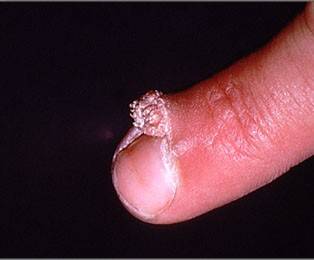Warts
Warts are small rough growths of skin caused by infection with human papilloma virus (HPV). The common warts occur on the fingers and feet (plantar warts) most often, and are frequently seen in children, though they can occur at any age.
There are more than 120 types of HPV. Certain types cause warts of the hands, others of the feet, and a few types cause genital warts. Yet others cause flat warts, which are very small but occur as crops of dozens in one area.
Everyone is exposed to warts from an early age. The immune system generally keeps the virus from forming warts. However, sometimes in a certain place, especially if there has been a cut in the skin, a wart may form. The immune system will react in time and remove the wart, but it is unpredictable how long it will take for this to occur. When the immune system is weak, due to illness or medications, the warts may remain on the skin longer.
Treatment
Warts do not always require treatment, as they often resolve on their own due to activity of the immune system. However, their resolution can be expedited by certain treatments that trigger the immune system to work locally.
Freezing (Cryotherapy)
Applying liquid nitrogen to the warts causes damage to this skin. The immune system comes to the area to repair the damage and can then attack the virus as well. Multiple treatments may be required to eliminate the wart. The treatment stings slightly, and the treatment site may be red or may blister after the treatment.
Laser
A laser called pulsed dye laser can be used to treat warts that are resistant to freezing. The laser heats the skin and destroys the small vessels that feed it. Multiple treatments may be needed. The treatment feels like the snap of a rubber band and may leave a small bruise for about one week. In very thick warts, a laser called CO2 may be used to burn the wart to the base, leaving a small wound. This treatment removes the visible wart, but it is more painful than pulsed dye laser, takes longer to heal, and has a higher risk of scarring. In addition, if the immune system does not remove any remaining viruses at the base, the wart may regrow.
Creams, ointments, solutions, and stickers
Retin-A: Flat warts, which are small and numerous may be treated with creams such as tretinoin (Retin-A).
Salicylic acid: Thick warts on the feet can be treated with salicylic acid to reduce the thickness of the skin. A formulation of salicylic acid that has 5-FU, a type of chemotherapy drug that stops the virus-containing cells from growing, can be used as well.
The information above is a partial and general information and cannot replace the needed specific medical examination and consultation

